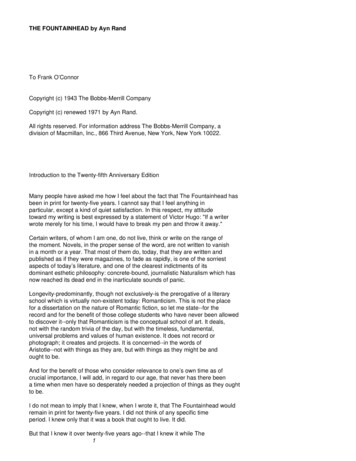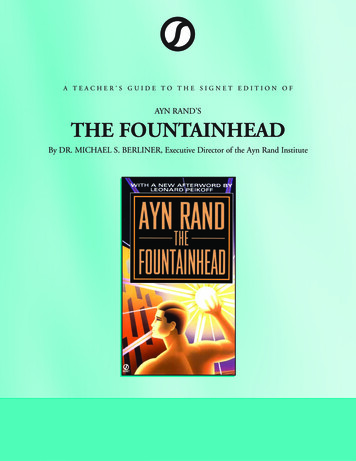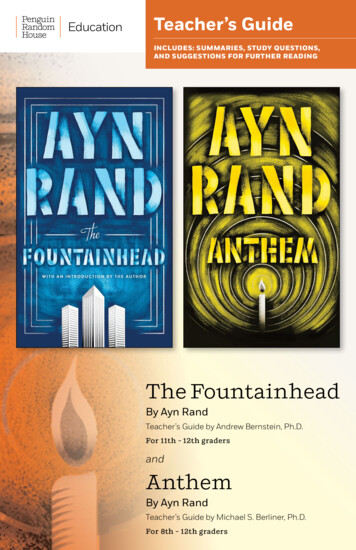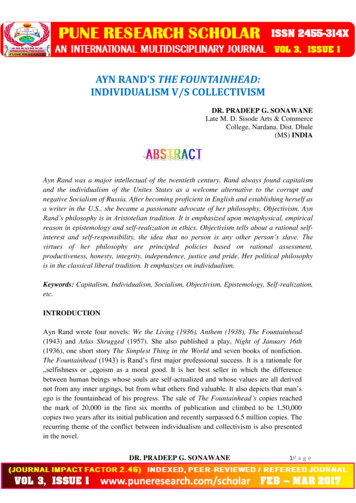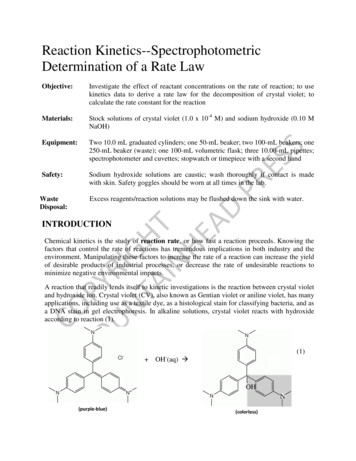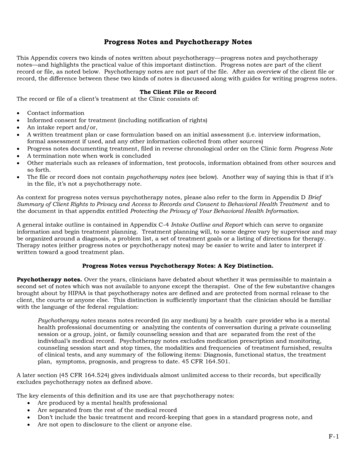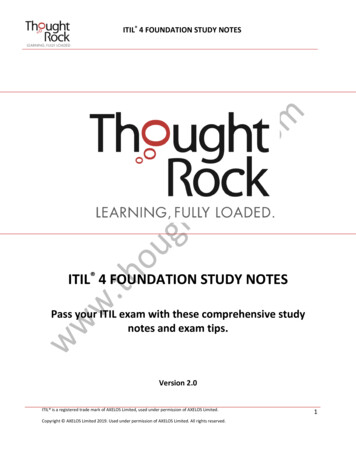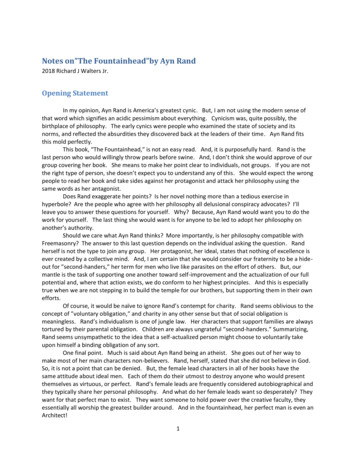
Transcription
Notes on”The Fountainhead”by Ayn Rand2018 Richard J Walters Jr.Opening StatementIn my opinion, Ayn Rand is America’s greatest cynic. But, I am not using the modern sense ofthat word which signifies an acidic pessimism about everything. Cynicism was, quite possibly, thebirthplace of philosophy. The early cynics were people who examined the state of society and itsnorms, and reflected the absurdities they discovered back at the leaders of their time. Ayn Rand fitsthis mold perfectly.This book, “The Fountainhead,” is not an easy read. And, it is purposefully hard. Rand is thelast person who would willingly throw pearls before swine. And, I don’t think she would approve of ourgroup covering her book. She means to make her point clear to individuals, not groups. If you are notthe right type of person, she doesn’t expect you to understand any of this. She would expect the wrongpeople to read her book and take sides against her protagonist and attack her philosophy using thesame words as her antagonist.Does Rand exaggerate her points? Is her novel nothing more than a tedious exercise inhyperbole? Are the people who agree with her philosophy all delusional conspiracy advocates? I’llleave you to answer these questions for yourself. Why? Because, Ayn Rand would want you to do thework for yourself. The last thing she would want is for anyone to be led to adopt her philosophy onanother’s authority.Should we care what Ayn Rand thinks? More importantly, is her philosophy compatible withFreemasonry? The answer to this last question depends on the individual asking the question. Randherself is not the type to join any group. Her protagonist, her ideal, states that nothing of excellence isever created by a collective mind. And, I am certain that she would consider our fraternity to be a hideout for ”second-handers,” her term for men who live like parasites on the effort of others. But, ourmantle is the task of supporting one another toward self-improvement and the actualization of our fullpotential and, where that action exists, we do conform to her highest principles. And this is especiallytrue when we are not stepping in to build the temple for our brothers, but supporting them in their ownefforts.Of course, it would be naïve to ignore Rand’s contempt for charity. Rand seems oblivious to theconcept of ”voluntary obligation,” and charity in any other sense but that of social obligation ismeaningless. Rand’s individualism is one of jungle law. Her characters that support families are alwaystortured by their parental obligation. Children are always ungrateful ”second-handers.” Summarizing,Rand seems unsympathetic to the idea that a self-actualized person might choose to voluntarily takeupon himself a binding obligation of any sort.One final point. Much is said about Ayn Rand being an atheist. She goes out of her way tomake most of her main characters non-believers. Rand, herself, stated that she did not believe in God.So, it is not a point that can be denied. But, the female lead characters in all of her books have thesame attitude about ideal men. Each of them do their utmost to destroy anyone who would presentthemselves as virtuous, or perfect. Rand’s female leads are frequently considered autobiographical andthey typically share her personal philosophy. And what do her female leads want so desperately? Theywant for that perfect man to exist. They want someone to hold power over the creative faculty, theyessentially all worship the greatest builder around. And in the fountainhead, her perfect man is even anArchitect!1
ObjectivismThe following points come from AynRand.Org:1. "Wishing won't make it so"a. Ayn Rand’s philosophy, Objectivism, begins by embracing the basic fact that existenceexists. Reality is, and in the quest to live we must discover reality’s nature and learn toact successfully in it.b. To exist is to be something, to possess a specific identity. This is the Law of Identity: A isA. Facts are facts, independent of any consciousness. No amount of passionate wishing,desperate longing or hopeful pleading can alter the facts. Nor will ignoring or evadingthe facts erase them: the facts remain, immutable.c. In Rand’s philosophy, reality is not to be rewritten or escaped, but, solemnly andproudly, faced. One of her favorite sayings is Francis Bacon’s: “Nature, to becommanded, must be obeyed.”d. Reality — that which exists — has no alternatives, no competitors, nothing“transcending” it. To embrace existence is to reject all notions of the supernatural andthe mystical, including God.2. "You can't eat your cake and have it, too"a. The essential advice of Rand’s philosophy is: embrace reason as an absolute. Thismeans: choose to face the facts at all times, in all areas, whether at work or at home, inbusiness or in love — and no matter what conclusion logically ensues, whether pleasantor unpleasant.b. The purpose of epistemology is to help teach us how to reason: how to thinkconceptually, how to properly define our terms, how to form and apply principles.c. Reason doesn’t work automatically. We have to choose to activate our minds, to setthem in motion, to direct them to the task of understanding the facts, and to activelyperform the steps that such understanding requires. Our basic choice in life is “to thinkor not.”d. To choose to follow reason, Rand argues, is to reject emotions, faith or any form ofauthoritarianism as guides in life.3. "Man is an end in himself"a. Why does man need morality?b. The typical answer is that we must learn to deny our own interests and happiness inorder to serve God or other people — and morality will teach us to do this.c. Rand’s answer is radically different. The purpose of morality, she argues, is to teach uswhat is in our self-interest, what produces happiness.d. “Man has,” she observes, “no automatic code of survival. . . . His senses do not tell himautomatically what is good for him or evil, what will benefit his life or endanger it, whatgoals he should pursue and what means will achieve them, what values his life dependson, what course of action it requires.”e. This is what the science of ethics studies — and what Objectivism offers. “Man mustchoose his actions, values and goals,” she summarizes, “by the standard of that which isproper to man — in order to achieve, maintain, fulfill and enjoy that ultimate value, thatend in itself, which is his own life.”2
4. “GIVE ME LIBERTY OR GIVE ME DEATH!”a. The ideal social system, Rand holds, is laissez-faire capitalism. Economically, this meansnot today’s mixture of freedom and government controls but “a complete separation ofstate and economics, in the same way and for the same reasons as the separation ofstate and church.”b. Rand’s advocacy of laissez-faire capitalism is a consequence of her deeper philosophicalviews. An individual who eagerly faces reality, who embraces his own rational mind asan absolute, and who makes his own life his highest moral purpose will demand hisfreedom. He will demand the freedom to think and speak, to earn property andassociate and trade, and to pursue his own happiness.c. Laissez-faire capitalism, Rand argues, is the system of individual rights. In such a systemthe government has only one function, albeit a vital one: to protect the rights of eachindividual by placing the retaliatory use of physical force under objective control.3
Themes of “The Fountainhead” Cynicism and the Great Person Theory of History. Great people create things too good for theaverage man.o “Look at it. A sublime achievement, isn’t it? A heroic achievement. Think of thethousands who worked to create this and of the millions who profit by it. And itis said that but for the spirit of a dozen men, here and there down the ages, but fora dozen men—less, perhaps—none of this would have been possible. And thatmight be true. If so, there are—again—two possible attitudes to take. We can saythat these twelve were great benefactors, that we are all fed by the overflow of themagnificent wealth of their spirit, and that we are glad to accept it in gratitude andbrotherhood. Or, we can say that by the splendor of their achievement which wecan neither equal nor keep, these twelve have shown us what we are, that we donot want the free gifts of their grandeur, that a cave by an oozing swamp and afire of sticks rubbed together are preferable to skyscrapers and neon lights—if thecave and the sticks are the limit of our own creative capacities. Of the twoattitudes, Dominique, which would you call the truly humanitarian one? Because,you see, I’m a humanitarian.”Don’t cast Pearls before swine attitudeo “you cast your pearls without a pork-chop to show for it”o “It does not matter that only a few in each generation will grasp and achieve thefull reality of man’s proper stature — and that the rest will betray it. It is thosefew that move the world and give life its meaning — and it is those few that Ihave always sought to address. The rest are no concern of mine; it is not me orThe Fountainhead that they will betray: it is their own souls.”Confidenceo After all of our recent lessons on self-reliance and liberty, here we have someonewho dares people to live confidently. Not to do so leads to the end where a manis unsure if he has lived a good life. To Rand, letting someone else take decisionsfor you is not living with confidence.Dominanceo The non-heroic characters, without inner drive, are all seeking a way to influencethose who do. They are desperate to think that they are powerful, and can breakthose who are actually powerful or great. They achieve this by twisting the rulesof society to their advantage. It is a philosophy of destruction in opposition to thephilosophy of creation.Selfishnesso People who live as mirrors, trying to please others, hoping that the approval ofothers will make them feel happy, make them feel importanto People who don’t care about anyone but themselves and their own passiono In the ancient argument “will living a virtuous life lead to happiness,” Ayn Randseems to say “absolutely not,” unless you let her redefine virtue first. To her,selfishness is a virtue.Freedomo True freedom is being untouched and invulnerable to coercion, and unwilling tocompromise. Not innocence, just focus on what is important to that person.4
Summary of the PlotPart 1 – Peter Keating Roark is expelled from StantonPeter is hired with the prestigious firm of Francon and HeyerPeter steals the job of the lead Draftsman at his firmToohey buys Peter’s respect and loyalty with a positive reviewPeter learns he is dating the niece of Ellsworth Toohey, a noted architectural columnistRoark goes to work for Henry Cameron (but Cameron soon goes out of business)Peter arranges to have the lead Architect leave his firm and assume his roleRoark helps Peter create his first real assignmentRoark goes to work for Peter at Francon and Heyer as a draftsmanGuy Francon fires RoarkRoark goes to work for John Erik Snyte as his ”modernist”Peter fights to break Catherine’s attention away from her Uncle TooheyPeter meets DominiqueRoark is fired by Snyte when he modifies a drawing in front of Austen HellerRoark builds the Heller House and Service StationCatherine freaks out about nothing a premonition. Wants to get married that night to Peter.Roark gets rejected by many people, no matter how sensible his sales pitchRoark gets mired up in the Sanborn residence and spends his commission fixing itRoark helps Peter cheat and win the Cosmo-Slotnic building competitionDominque rejects Peter’s proposal, warning him she would marry him only to punish herselfPeter essentially kills Heyer, Francon’s partner of his Architectural firmPeter is made a partner in the new Firm, Francon and KeatingRoark is turned down by the Manhattan Bank Company and has to close his officePart 2 – Ellsworth Toohey Roark goes to work in the quarry owned by Guy Francon, and is spotted by DominiqueDominique lures Roark to her house to fix a fireplace she purposefully damagedDominique is raped by RoarkRoark is granted the Enright house job and returns to New York CityPeter wins the Cosmo Slotnick building competitionToohey reviews Peter’s design and praises him to the heavensStephen Mallory tries shoots at Ellsworth Toohey and is basically pardoned by TooheyDominique sees the drawings for the Enright HousePeter is made chairman of the Council of American Builders by TooheyToohey shows some of his radical nature at the first meeting of the CABRoark attends a party at Kiki Holcolmb’s and runs into DominqueToohey and Dominique square off at the partyDominique convinces Joel Sutton to drop Roark as his architect of choiceDominique sleeps with Roark, telling him she will do it again each time she hurts him5
Dominique sets out to destroy Roark professionally while sleeping with him personallyDominique admits that she and Toohey are alliesRoark builds Enright HouseDominique continues to drive commissions away from Roark, giving them to Peter KeatingPeter tries to thank Dominque, and regrets itEllsworth’s back storyRoark gets commissions for Norris House and Cord BuildingRoark wins commission of Aquitania hotel with the help of Kent LansingDominique tells Toohey that Roark is beating himToohey tricks Roark into building the Temple of the Human Spirit for Hopton StoddardToohey tells Dominique that he gave the Stoddard job to RoarkToohey essentially tells Peter to marry Dominique, if he could mange itRoark commissions a naked statue of Dominique for his templeDominique tells Toohey about the statue and that she let Roark know Toohey’s role in thetempleThe Aquitania project fails due to money concerns, and is named the ”unfinished symphony”Roark is sued concerning the TempleToohey explains his victory over Roark to DominiqueDominique testifies at trial, cryptically endorsing Roark saying the Temple is too good for menPeter promises to marry Catherine but marries Dominique insteadToohey buys the statue of Dominique and gives it to Gail WynandPart 3 – Gail Wynand Gail Wynand’s Back storyDominique destroys Peter with a mirroring of his own desiresToohey tells Peter that Dominique can meet with Wynand to get StoneridgeDominique meets with Wynand and he agrees to take her on a trip for two months for thecontract.Wynand tortures Peter at dinner revealing the dealWynand shows Dominique his private galleryWynand reveals the meaning of the name of his yachtWynand and Dominique talk frankly and he proposes to her. She accepts.Wynand buys off Peter.Roark is working in OhioToohey scrambles to adjust his plans against WynandDominique visits Roark on her way to marry Gail WynandDominique offers to stay in Ohio if Roark will give up Architecture. He refuses.Toohey embraces the simplicity of modern architecture.Peter struggles to build StoneridgeGuy Francon retires and Peter takes Neil Dumont as his partnerDominique gets her divorce granted in RenoGail and Dominique have a large wedding in a hotel. Dominique wears black.Toohey uses the scandal to plant seeds about Gail Wynand, and is buying stock in the BannerWynand selfishly keeps Dominique in his penthouse like a piece of art6
Dominique takes Wynand to see the play”No Skin Off Your Nose”Dominique and Gail realize that they are very much alike.Dominique tries to get Gail to fire Toohey.Part 4 – Howard Roark A boy discovers Monadnock Valley.Story of Monadnock Valley’s constructionRoark completes the Aquitania HotelMonadnock Valley’s owners sold 200% of the project to investorsRoark becomes somewhat infamousThe other architects all collaborate on the ”March of the Centuries” fairRoark moves into the Cord Building.Gail Wynand hires Howard Roark, and the Bromance begins.Toohey learns that Roark and Wynand are in contact, but not whyWynand reads up on RoarkWynand tries to imprison Roark, but he stays out of the trap.Gail shows Dominique the drawingsRoark comes to dinner with Gail and Dominique to reveal the houseGail makes a dinner date with Howard, in personWynand tells Toohey not to write about RoarkThe Bromance continues while building the house.Intellectual socialists sit and talk about their beliefs. And ”We don’t read Wynand” movement.Peter is downsizing. Toohey has distanced himself.Peter begs Toohey to give him the Cortlandt Homes project.Toohey tells Peter that Cortlandt will only go to the best economic design.Peter takes the project to RoarkRoark agrees to Design Cortlandt if Peter prevents the design from being altered.Toohey sees the designs and praises PeterGail decides to start using his paper to turn opinion the way he wantsGail’s campaign backfiresGail takes Roark to Hell’s Kitchen to discuss his skyscraper ideaPeter runs into Katie (Catherine) and she is no longer the girl she wasGail and Howard go on a 3 month cruise, maturing the bromance. Dominique is left behind.On the Yacht, Roark gives the ”second handers” speechHoward returns to find that Cortlandt is not the way it should beRoark enlists Dominique in a conspiracyRoark blows up CordlandtDominique is injured in the explosionRoark gets to talk to Dominique before the trial. She says the words he has wanted to hear.Toohey and the world attack Roark for his egoismGail defends Howard with the BannerToohey visits Peter, revealing himself as Peter’s master and the villain of the storyToohey receives proof that Howard built Cordlandt and delivers it to the District AttorneyWhile Alvah is out sick, Toohey publishes an article damning Roark7
Wynand fires Toohey and others starting a general strike at the BannerGail tries to save the Banner through effort. Even Dominique comes to help him.Gail visits Roark and Roark encourages Gail not to quit, but that public opinion won’t matterThe board of directors meets and Gail gives in.An editorial damning Roark goes out with Gail’s name on it. He didn’t hold out.Gail walks the city and realizes he never got out of Hell’s Kitchen. His power was an illusion.Dominique goes back to Roark, staging a robbery to get her ”affair” into the papers for Gail tosee.Gail runs the story of his own scandal in the Banner. His reputation is absolved.Dominique meets with Gail and explains that she knew Roark since the quarry.Dominique reconciles with her fatherRoark stacks the jury of his trial with hard-hearted working men and executives.Roark gives a long speech about creators and parasites, individualism vs collectivismRoark is found not-guiltyToohey wins his union lawsuit to be restored to his job at the bannerWynand brings Toohey back to the Banner 10 minutes before he closes it foreverToohey is employed by the Courier and sets out to take over there as wellRoark meets Wynand to receive the commission for the Wynand buildingThe book ends with Dominique joining Roark on the top of the skeleton of the new building8
Description of the Key CharactersThe following quotations come from Ayn Rand’s notebook:Howard Roark “The noble soul par excellence. The man as man should be. The self-sufficient, self-confident,the end of ends, the reason unto himself, the joy of living personified. Above all—the man wholives for himself, as living for oneself should be understood. And who triumphs completely. Aman who is what he should be.”Ellsworth Toohey “Noted economist, critic and liberal.”Noted”anything and everything.Great”humanitarian”and”man of integrity.”Glorifies all forms of collectivism because he knowsthat only under such forms will he, as the best representative of the mass, attain prominenceand distinction, impossible to him on his own merits which do not exist. The idol-crusher parexcellence. Born, organic enemy of all things heroic. Has a positive genius for thecommonplace. Worst of all possible rats. A man who never could be—and knows it.”Dominque Francon “The woman for a man like Howard Roark. The perfect priestess.”Peter Keating “The exact opposite of Howard Roark, and everything a man should not be. A perfect exampleof a selfless man who is a ruthless, unprincipled egotist—in the accepted meaning of the word.A tremendous vanity and greed, which lead him to sacrifice all for the sake of a”brilliantcareer”A mob man at heart, of the mob and for the mob. His triumph is his disaster. Left as anempty, bitter wreck, his”second-hand life”takes the form of sacrificing all for the sake of avictory which has no meaning and gives him no satisfaction. Because his means become his end.He shows that a selfless man cannot be ethical. He has no self and, therefore, cannot have anyethics. A man who never could be [man as he should be]. And doesn’t know it.”Gail Wynand “A man who rules the mob only as long as he says what the mob wants him to say. Whathappens when he tries to say what he wants. A man who could have been.”9
Notable QuotationsHoward Roark1. Heller and Roark: “What is it that I like so much about the house you’re building for me, Howard?”“A house can have integrity, just like a person,” said Roark, ”and just as seldom.” “In what way?”“Well, look at it. Every piece of it is there because the house needs it — and for no other reason.You see it from here as it is inside. The rooms in which you’ll live made the shape. The relation ofmasses was determined by the distribution of space within. The ornament was determined by themethod of construction, an emphasis of the principle that makes it stand. You can see each stress,each support that meets it. Your own eyes go through a structural process when you look at thehouse, you can follow each step, you see it rise, you know what made it and why it stands. Butyou’ve seen buildings with columns that support nothing, with purposeless cornices, with pilasters,mouldings, false arches, false windows. You’ve seen buildings that look as if they contained a singlelarge hall, they have solid columns and single, solid windows six floors high. But you enter and findsix stories inside. Or buildings that contain a single hall, but with a façade cut up into floor lines,band courses, tiers of windows. Do you understand the difference? Your house is made by its ownneeds. Those others are made by the need to impress. The determining motive of your house is inthe house. The determining motive of the other is in the audience.”2. Ellsworth Toohey explaining to Hopton Stoddard how to approach Roark so he will build hisTemple of the Human Spirit: “But you must be careful about approaching him. I think he will refuseto do it, at first. He will tell you that he doesn’t believe in God.” “What!” “Don’t believe him. He’sa profoundly religious man — in his own way. You can see that in his buildings.” “Oh.” “But hedoesn’t belong to any established church.”3. Hopton Stoddard pitching Roark the opportunity to build a physical representation of his ownphilosophy: “So you see, Mr. Roark, though it is to be a religious edifice, it is also more than that.You notice that we call it the Temple of the Human Spirit. We want to capture — in stone, as otherscapture in music — not some narrow creed, but the essence of all religion. And what is the essenceof religion? The great aspiration of the human spirit toward the highest, the noblest, the best.The human spirit as the creator and the conqueror of the ideal. The great life - giving force of theuniverse. The heroic human spirit. That is your assignment, Mr. Roark.”4. Stephen Mallory to Howard Roark: “You said something yesterday about a first law. A lawdemanding that man seek the best. It was funny. The unrecognized genius — that’s an oldstory. Have you ever thought of a much worse one — the genius recognized too well?. That agreat many men are poor fools who can’t see the best — that’s nothing. One can’t get angry at that.But do you understand about the men who see it and don’t want it?” “No.” “No. You wouldn’t. Ispent all night thinking about you. I didn’t sleep at all. Do you know what your secret is? It’s yourterrible innocence.” Roark laughed aloud, looking at the boyish face. ”No,” said Mallory, ”it’s notfunny. I know what I’m talking about — and you don’t. You can’t know. It’s because of thatabsolute health of yours. You’re so healthy that you can’t conceive of disease. You know of it. Butyou don’t really believe it. I do. I’m wiser than you are about some things, because I’m weaker.”5. Roark explains what a building should represent to Gail Wynand: “Most people build as they live— as a matter of routine and senseless accident. But a few understand that building is a greatsymbol. We live in our minds, and existence is the attempt to bring that life into physical reality, tostate it in gesture and form. For the man who understands this, a house he owns is a statement ofhis life. If he doesn’t build, when he has the means, it’s because his life has not been what hewanted.”10
6. Gail Wynand asks Roark if he likes being who he is: “I’m going to change my mind and ask you apersonal question. You said you’d answer anything.” “I will.” “Have you always liked being HowardRoark?” Roark smiled. The smile was amused, astonished, involuntarily contemptuous. ”You’veanswered,” said Wynand.7. Roark reveals more of his philosophy to Gail: “Howard, have you ever been in love?” Roark turnedto look straight at him and answer quietly: ”I still am.” “But when you walk through a building, whatyou feel is greater than that?” “Much greater, Gail.” “I was thinking of people who say thathappiness is impossible on earth. Look how hard they all try to find some joy in life. Look how theystruggle for it. Why should any living creature exist in pain? By what conceivable right can anyonedemand that a human being exist for anything but for his own joy? Every one of them wants it.Every part of him wants it. But they never find it. I wonder why. They whine and say they don’tunderstand the meaning of life. There’s a particular kind of people that I despise. Those who seeksome sort of a higher purpose or ‘universal goal,’ who don’t know what to live for, who moan thatthey must ‘find themselves. ’ You hear it all around us. That seems to be the official bromide ofour century. Every book you open. Every drooling self - confession. It seems to be the noble thingto confess. I’d think it would be the most shameful one.” “Look, Gail.” Roark got up, reached out,tore a thick branch off a tree, held it in both hands, one fist closed at each end; then, his wrists andknuckles tensed against the resistance, he bent the branch slowly into an arc. ”Now I can makewhat I want of it: a bow, a spear, a cane, a railing. That’s the meaning of life.” “Your strength?”“Your work.” He tossed the branch aside. ”The material the earth offers you and what you make ofit. What are you thinking of, Gail?” “The photograph on the wall of my office.”8. Roark explains his individualism to Peter: “Now listen to me. I’ve been working on the problem oflow - rent housing for years. I never thought of the poor people in slums. I thought of thepotentialities of our modern world. The new materials, the means, the chances to take and use.There are so many products of man’s genius around us today. There are such great possibilities toexploit. To build cheaply, simply, intelligently. I’ve had a lot of time to study. I didn’t have much todo after the Stoddard Temple. I didn’t expect results. I worked because I can’t look at any materialwithout thinking: What could be done with it? And the moment I think that, I’ve got to do it. To findthe answer, to break the thing. I’ve worked on it for years. I loved it. I worked because it was aproblem I wanted to solve. You wish to know how to build a unit to rent for fifteen dollars a month?I’ll show you how to build it for ten.” Keating made an involuntary movement forward. ”But first, Iwant you to think and tell me what made me give years to this work. Money? Fame? Charity?Altruism?” Keating shook his head slowly. ”All right. You’re beginning to understand. So whateverwe do, don’t let’s talk about the poor people in the slums. They have nothing to do with it, though Iwouldn’t envy anyone the job of trying to explain that to fools. You see, I’m never concerned withmy clients, only with their architectural requirements. I consider these as part of my building’stheme and problem, as my building’s material — just as I consider bricks and steel. Bricks and steelare not my motive. Neither are the clients. Both are only the means of my work.”9. Roark feels pity for Peter: When Keating had gone, Roark leaned against the door, closing his eyes.He was sick with pity. He had never felt this before — not when Henry Cameron collapsed in theoffice at his feet, not when he saw Steven Mallory sobbing on a bed before him. Those momentshad been clean. But this was pity — this complete awareness of a man without worth or hope, thissense of finality, of the not to be redeemed. There was shame in this feeling — his own shame thathe should have to pronounce such judgment upon a man, that he should know an emotion whichcontained no shred of respect. This is pity, he thought, and then he lifted his head in wonder. Hethought that there must be something terribly wrong with a world in which this monstrous feeling iscalled a virtue.11
10. Roark reflects that he thinks that selflessness is the root of all evil: “What have you been thinkingabout, these past weeks?” “The principle behind the dean who fired me from Stanton.” “Whatprinciple?” “The thing that is destroying the world. The thing you were talking about. Actualselflessness.”11. Roark explains the concept of a “second hander” to Gail: Look at Peter Keating.” “You look athim. I hate his guts.” “I’ve looked at him — at what’s left of him — and it’s helped me tounderstand. He’s paying the price and wondering for what sin and telling himself that he’s been tooselfish. In what act or thought of his has there ever been a self? What was his aim in life? Greatness— in other people’s eyes.
Jul 03, 2018 · Notes on”The Fountainhead”by Ayn Rand 2018 Richard J Walters Jr. Opening Statement In my opinion, Ayn Rand is America [s greatest cynic. But, I am not using the modern sense of that word which signifies an acidic pessimism about everything. Cy

